#Common Blue Mud-dauber Wasp
Text

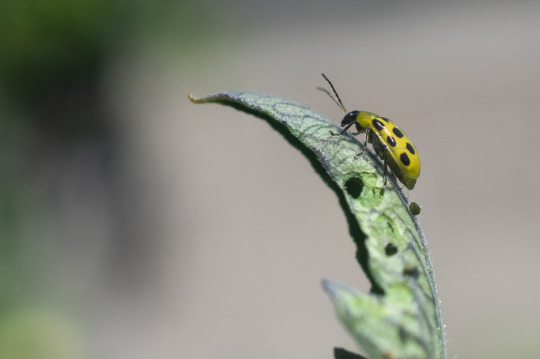

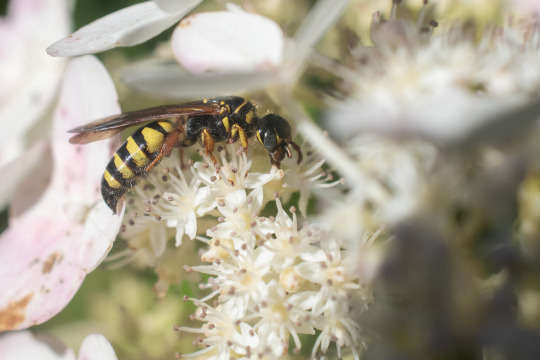
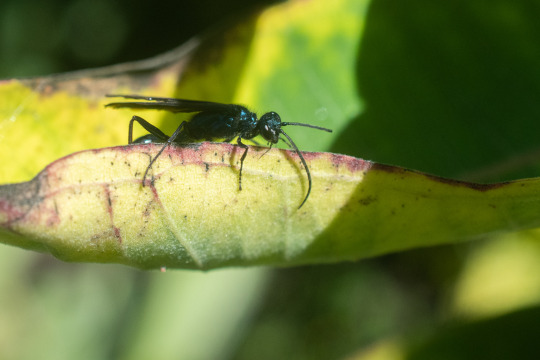


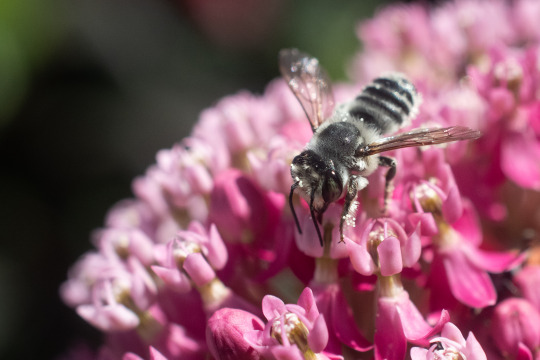





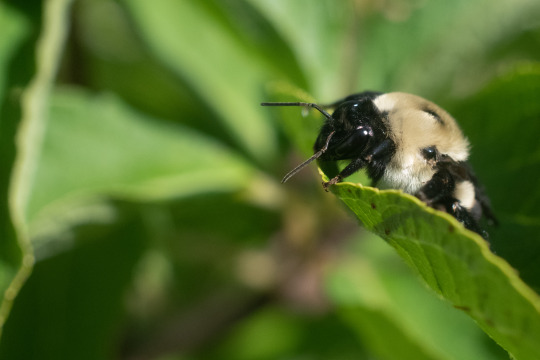
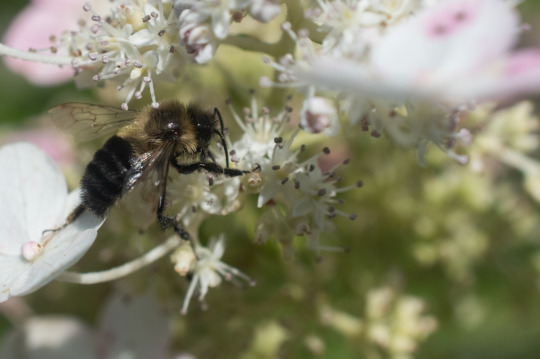
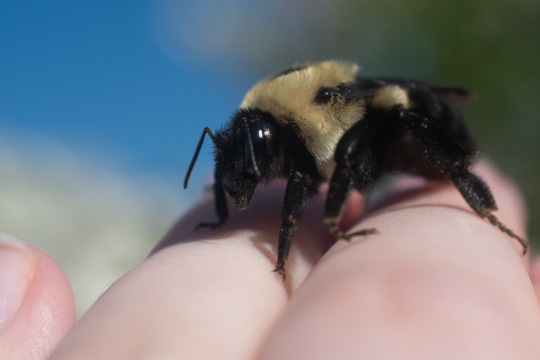


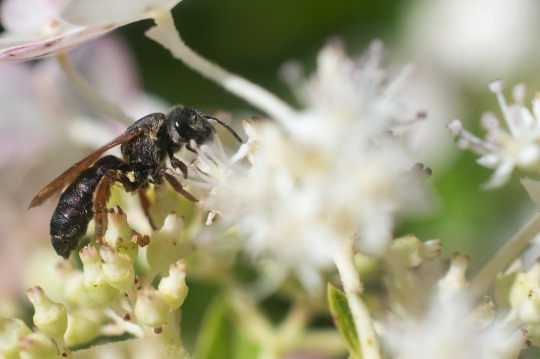

European Paper Wasp (Polistes dominula) ♂
Spotted Cucumber Beetle (Diabrotica undecimpunctata)
Great Golden Digger Wasp (Sphex ichneumoneus)
Five-banded Thynnid Wasp (Myzinum quinquecinctum)
Common Blue Mud-dauber Wasp (Chalybion californicum)
Chrysidini sp.
Four-banded Stink Bug Wasp (Bicyrtes quadrifasciatus)
Megachile sp.
Parallel-striped Sweat Bee (Halictus parallelus)
Myzinum maculatum ♀
Archytas apicifer?
Goldenrod Soldier Beetle (Chauliognathus pensylvanicus)
Archytas apicifer?
Common Eastern Bumble Bee (Bombus impatiens) ♀
Common Eastern Bumble Bee (Bombus impatiens) ♂
Common Eastern Bumble Bee (Bombus impatiens) ♀
Lobed Mason Wasp (Ancistrocerus antilope)
Narrow-headed Marsh Fly (Helophilus fasciatus)
Hawthorn Mining Bee (Andrena crataegi)?
Vespula Sp.
Foaming at the mouth at the absolute biodiversity in my yard this year! We have this bush in the yard that the wasps, bees and flies are obsessed with, which is where I took most of the pictures.
I also noticed these HUGE flies which I've never seen before. Usually if you even look in the general direction of a fly it immediately takes off but these ones could not care less, I could put my hand right up to them and they didn't move until I physically touched them.
Also once again completely baffled by the people who talk about how "aggressive" and "mean" wasps are and how they constantly get stung. What are you guys doing??? None of the above species gave a single shit about me shoving my macro lens in their faces, and if it was windy I would sometimes grab the branch they were on to hold it steady and none of them even reacted.
The queen bee (which has a stinger unlike the males) also made no effort to sting me, after picking her up for a photo she actually refused to get off of my hand because she wanted to sit on me and groom her face.
We've also had lots of yellowjackets (I'm so bad at IDing them so no idea on species) approaching us recently and checking us out, flying extremely close and looking at us and then flying away. Even if I put my hand up in front of them to see if they want to land they sort of just look at it and then fly away.
Last year there were paper wasps on nests in my yard and they would stare at me warily but never sting me when I photographed them.
Also feel free to ID things on my iNaturalist or correct me on any IDs here!
#Long Post#Not Pets#Wildlife Photography#Invertebrates#European Paper Wasp#Spotted Cucumber Beetle#Great Golden Digger Wasp#Five-banded Thynnid Wasp#Common Blue Mud-dauber Wasp#Four-banded Stink Bug Wasp#Parallel-striped Sweat Bee#Goldenrod Soldier Beetle#Common Eastern Bumble Bee#Lobed Mason Wasp#Narrow-headed Marsh Fly#Hawthorn Mining Bee#Yellowjacket
1 note
·
View note
Text






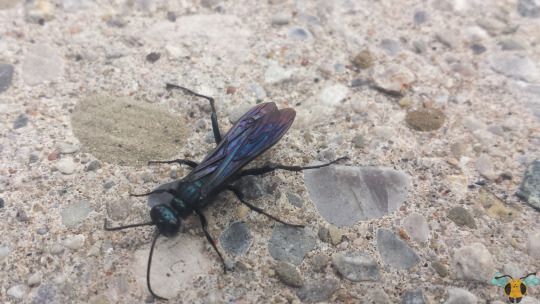

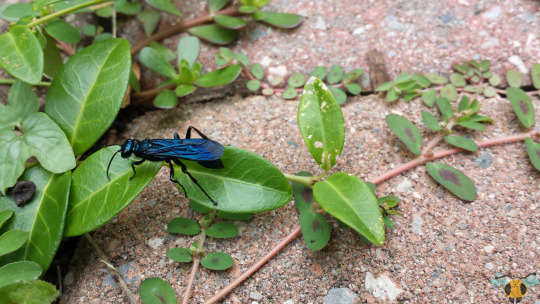

Common Blue Mud Dauber Wasp - Chalybion californicum
Returning from the long weekend cottage trip in Caledon, I'm so excited to share all the new insects I photographed there! There'll be quite a few to explore over the next few weeks, but before that, a prelude featuring an insect on hunt while we were loading the car. I've also added a few pictures from the beginnings of my insect photography hobby to show the insect in a more neutral position. As mentioned in earlier posts, solitary Digger Wasps make ground burrows or nests (this specie builds cells into a nest out of mud) and place their eggs inside. The eggs await a provision of food which the mother Wasp tirelessly hunts for; when the former hatch, they will have enough solid food to last them through to pupation. The Blue Mud Dauber's prey items of choice are spiders: any kind as long as they can be captured. While a video would've been better in hindsight to show how she hunts, they pictures before you here showcase the stinging and seizing inflicted by a mother Wasp. When we all first noticed her, he was flying around the garage door but not in an erratic fashion.
She was flying around systemically, combing as much air space as she could along the border of the garage door (occasionally landing) until reaching the top where she found cobwebs. I was grateful as while flying and landing these Wasps are very skittish making photography difficult, but little did I know what was really going on. After navigating her way closer to the web, she used her legs and head to twang and create movement in web, drawing the attention of a spider that crawled out from a dense web ball. The trap was set! In about 3 seconds, the spider rushed to investigate the "prey" entangled in the web and at the last second, the Wasp launched herself and enveloped the spider with her legs. By grappling the spider, the Mud Dauber can orient herself to navigate her paralyzing sting into the spider and then restrain it for easier transportation. This, along with the advantage of flight allows Wasps to effectively hunt and capture spiders, but they shouldn't get too arrogant as the winner is always the one who gets the last bite. This time, mama Wasp won. After the spider stopped struggling, the Dauber dropped from the threads and flew off, carrying her prize with her back to her muddy nest.
Pictures of the hunt were taken on June 30, 2023 with a Google Pixel 4. Supplementary pictures were taken on June 27 and September 11, 2018 with a Samsung Galaxy S4.
#jonny’s insect catalogue#ontario insect#wasp#common blue mud dauber wasp#blue mud dauber wasp#digger wasp#hymenoptera#insect#toronto#june2023#2023#september2018#june2018#2018#nature#entomology#spider#invertebrates#arthropods
3 notes
·
View notes
Text
truly cannot overstate how important it is for everyone to do research into local insect species and just try to notice them when you go outside. there are beautiful metallic blue mud dauber wasps where i live and they’re common in the summer but i just never noticed them until this past year. there are so many dragonflies at the local park. in one walk this june i found ebony jewelwing damselflies and an enormous stinkbug and an emerald-coloured tiger beetle and there is honest to god so much beauty in the insect world if you are willing to look for it
#speaky girl#bugs#insects#bugblr#even 'common' insects!#there are these BRIGHT RED flies at the park#there are so many kinds of ants#sweat bees exist and they're metallic green#idk. look at bugs#this has been a psa
9K notes
·
View notes
Text
Every Current Formula 1 Driver But I Decided They Were All Bugs
No Thoughts, Head Empty, Only Insects I Enjoyed From My Single Entomology Class Several Years Ago. Sorry to folks from outside the states. Most of these are like. my local critters.
Max Verstappen - Appalachian Jewelwing, Calopteryx angustipennis I have no reasoning behind this one. He just gives me the vibes of a damselfly kinda man.
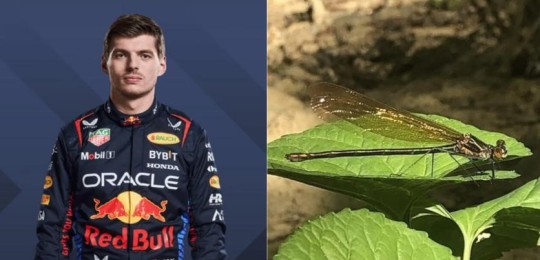
Sergio Pérez - Synoeca Cyanea, a species of warrior wasp, or just the Synoeca genus again, literally no justification besides he's on the dark blue team and I just really like these wasps. Please read the Synoeca wikipedia page. they are SO cool.

Lewis Hamilton - Violet Carpenter Bee, Xylocopa violacea fashionable! cool lookin bee!
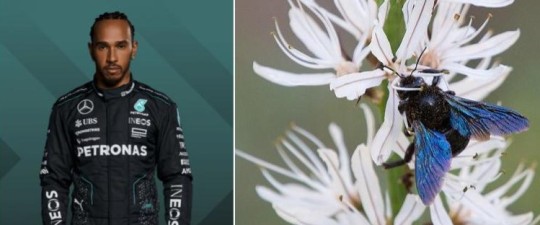
George Russell - Blue Hawker, Aeshna cyanea

Charles Leclerc - Cattle Killer/Cow Killer, Dasymutilla occidentalis (letting my south midwestern hick jump OUT here. most folks call em velvet ants)
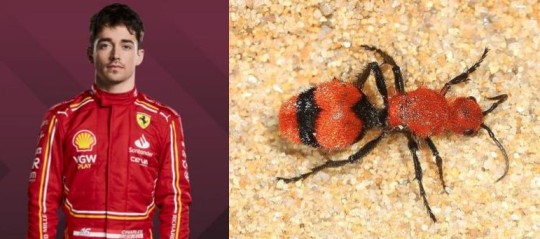
Carlos Sainz - Red Admiral, Vanessa atalanta
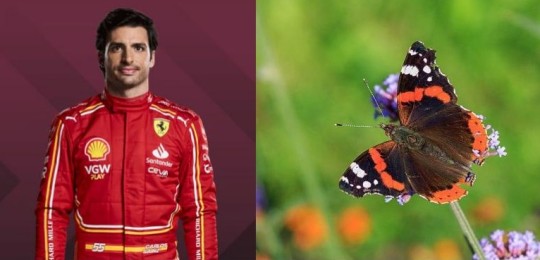
Lando Norris - Walker's Cicada, Megatibicen pronotalis this is NOT meant to be a drag I actually love these freakishly loud animals but he just gives bright green cicada energy.

Oscar Piastri - Green Carpenter Bee, Xylocopa aerata cop out? yeah. good bee and something that feels correct? yes.

Fernando Alonso - Mourning Cloak, Nymphalis antiopa i love these fuckin bugs. absolute freaks of nature. they live for like a full year and they're always wandering around and getting up to something. plus they're very distinguished.
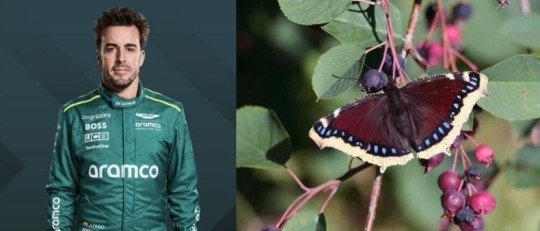
Lance Stroll - Common Buckeye, Junonia coenia I'm not even gonna elaborate on this one.

Valtteri Bottas - Eastern Cicada Hawk, Sphecius speciosus I just think they're neat!
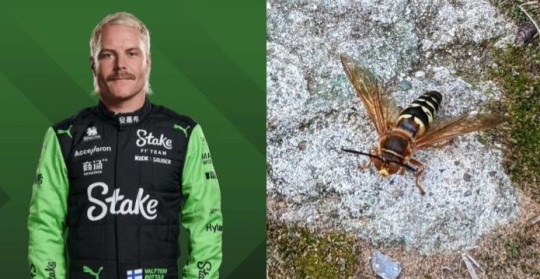
Zhou Guanyu - Ebony Jewelwing, Calopteryx maculata blatant favoritism here. The ebony jewelwing is perhaps my all time favorite bug from home :) (its also v stylish)
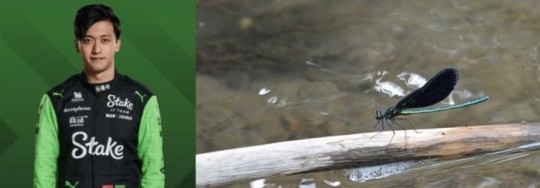
Esteban Ocon - Chinese Mantis, Tenodera sinensis a noble creature that frequently scares the life out of me when i find one outside my window. Why the fuck are you so long. I appreciate u anyway.

Pierre Gasly - European Field Cricket, Gryllus campestris he just *feels* a bit crickety. Idk what to tell u man.

Kevin Magnussen - Halloween Beetle (or in America, the Japanese Lady Bug), Harmonia axyridis the most determined little bastard in the animal kingdom. They WILL get into your apartment through that microscopic sliver in the window.

Nico Hulkenberg - Green June Beetle, Cotinis nitida idk dude he just serves local scarab

Daniel Ricciardo - Black-And-Yellow Mud Dauber, Sceliphron caementarium im sure you are all noticing how much i love wasps by now. i was SO brave not making this a wasp only post. if ur american and a hick (hey girl(gn) hey) you'll know these guys From Constantly Being In Your Car's Inner Workings

Yuki Tsunoda - Bullet Ant, Paraponera clavata tiny but mighty!!!!! (short king solidarity)
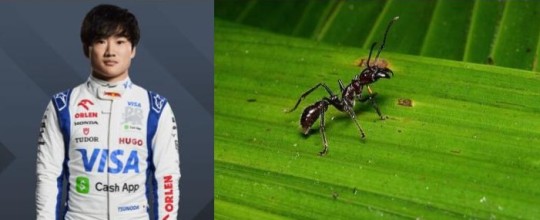
Alex Albon - Great Black Wasp, Sphex pensylvanicus yet more blatant favoritism for my faves. Yes this post is so i can assign the williams boys and zg my fave types of local bugs. Anyway. this is one of the best wasps in the world. if u see her irl please stop for a moment to appreciate her. she's usually a docile species but she is very big and i love her. (good hunter too)
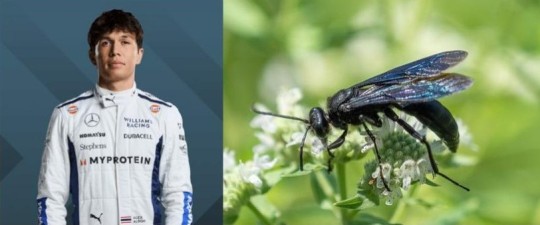
Logan Sargeant - Blue Dasher, Pachydiplax longipennis the ultimate late spring and all of summer insect of america. voted america's sweetheart of every local body of water eight millionth year in a row!!!! one of the best dragonflies in the country and i am serious!!! if u live in north america this summer, find a LAKE, a POND, A RIVER, perhaps even a CREEK!!!!!! A POOL WILL EVEN GET YOU! you'll find these folks. at current you might catch mating flight season!!! anyway. these are crazy good hunters and they're a beautiful little baby blue shade. anyway. logan and the rest of williams should go huntin for these when he gets back to florida. think it would fix em.
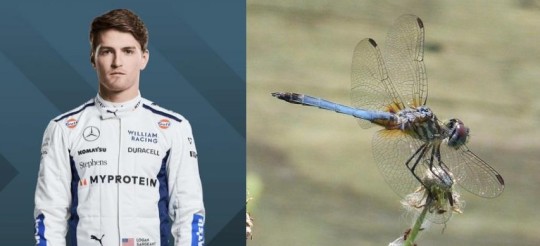
#zoomies posting#kazoo noises#babys first f1 season#sports posting#i said id do it and i was very serious#also sorry for the funky ordering i did this like in order that i thought of them and then had to match the teammates to whoever i did firs#this is why williams are the last ones here. i could NOT decide which wasp alex was gonna be
46 notes
·
View notes
Text
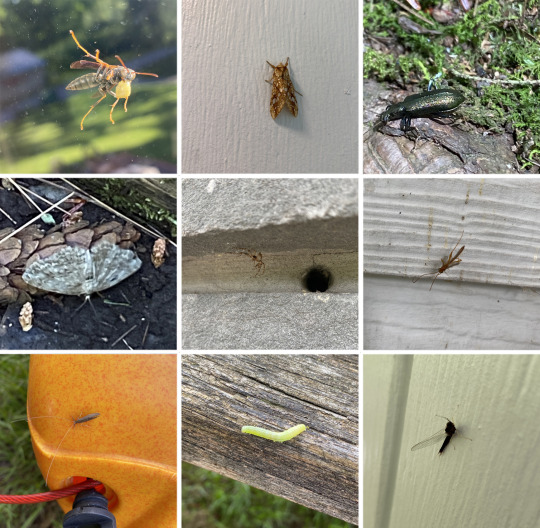
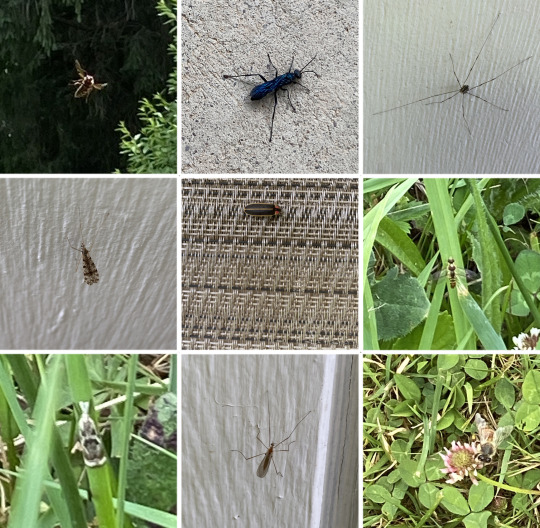
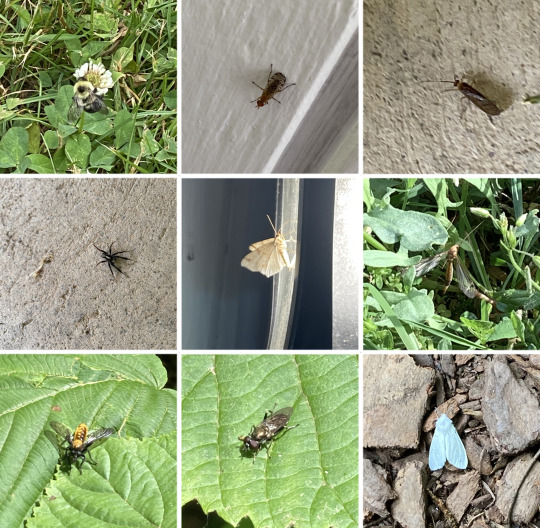
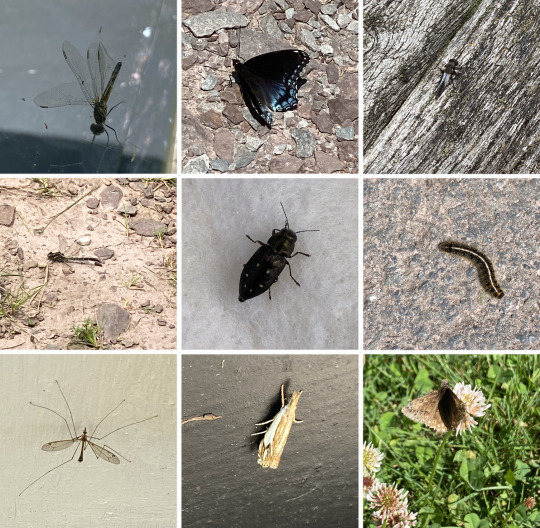
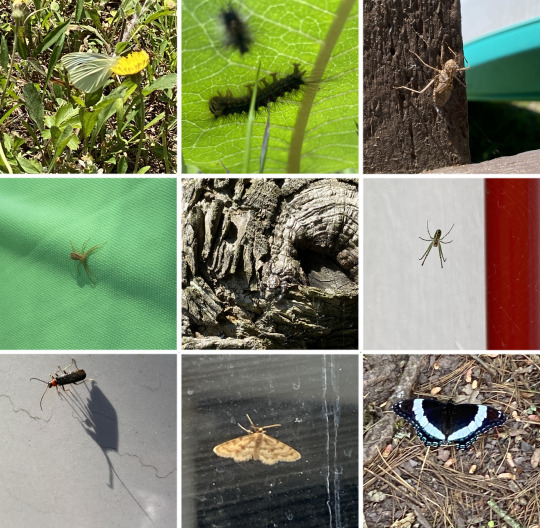
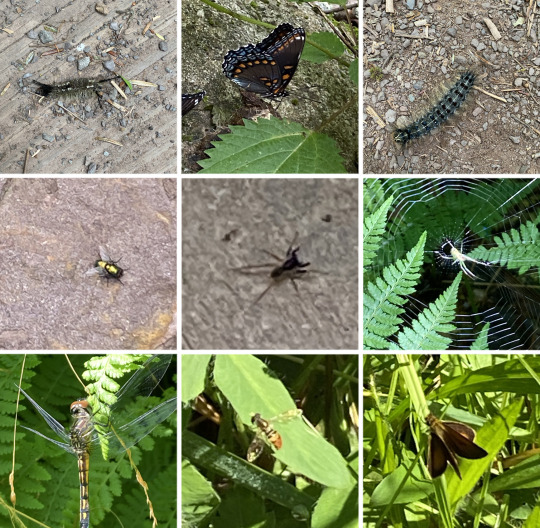
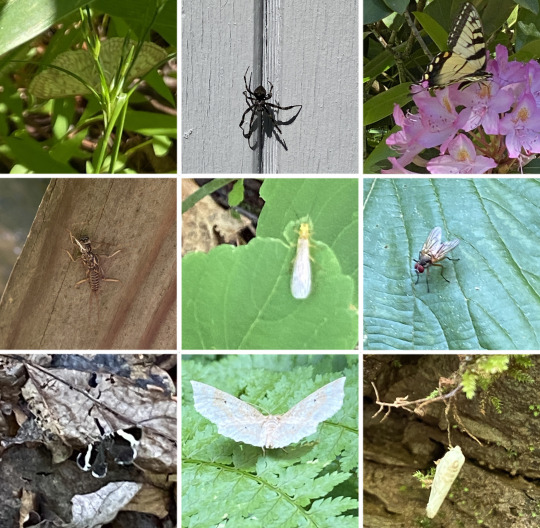
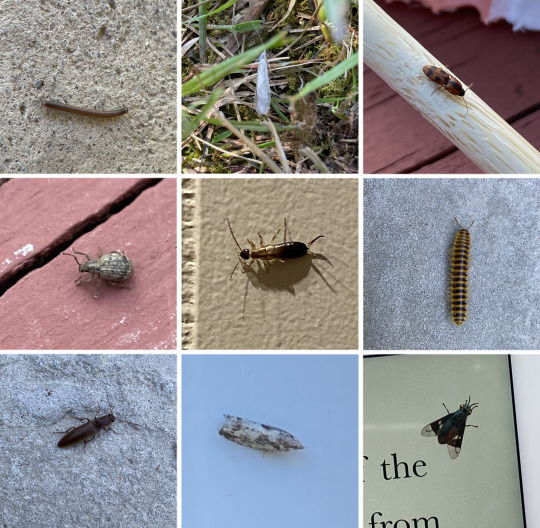
Zuzu's bug-ventures June 8-16, 2024 (insects/spiders from a state park in northeast Pennsylvania) (re-uploading because of file size issues)
I figured I would make a collage after getting so many! A couple of the above photos have duplicates, so all in all I believe I found 65 distinct kinds. I'm still working to ID some of them, but all the ones I think I have ID'd are under the cut. Anyway, it was truly a fun experience. Maybe next time I'll have a camera that isn't a shitty phone!
You can see full size photos of most of these here.
IDs under the cut
Just a note, I'm not 100% on any of these. My IDs are speculative based on google searches, reddit, and so-on. If you think something is wrong, PLEASE let me know!
Also, each image has 9 insects/spiders in a grid. I will be referring to each grid of 9 insects/spiders as a single image below, and identifying all 9 based on rows within the image. If that makes sense. Hopefully it does!
Image 1 (first row left):
Top row (from left to right): Northern paper wasp (I'm told it's carrying caterpillar meat); Hickory tussock moth; Ground beetle of some kind (could not ID)
Middle row: Fall cankerworm moth; Barn spider; Red ichneumon wasp
Bottom row: Long-horned caddisfly; Copper underwing caterpillar; Brush-legged mayfly
Image 2 (first row right):
Top row: Very loud very big bee (could not ID); Common blue mud dauber wasp; Harvestman spider
Middle row: Limoniid crane fly; Firefly; Hoverfly
Bottom row: Elegant grass-veneer moth; Tiger crane fly; Western honey bee
Image 3 (second row left):
Top row: Two-spotted bumble bee; Marsh fly; Yellow-collared scape moth? (could not ID)
Middle row: Wolf spider (male); Macaria moth; Tipula lunata (type of crane fly)
Bottom row: Robber fly; Brown-toed forest fly; Virginian tiger moth
Image 4 (second row right):
Top row: Blue dasher dragonfly? (could not ID. Dead in spider web); White admiral butterfly; Chalk-fronted corporal dragonfly
Middle row: Clubtail dragonfly? (could not ID); Hemlock borer beetle; Eastern tent caterpillar
Bottom row: Another Tipula lanata crane fly; Double-banded grass-veneer moth; Horace's duskywing butterfly
Image 5 (third row left):
Top row: Cabbage white butterfly; Spongy moth caterpillar; Dragonfly exoskeleton (could not ID)
Middle row: White-striped running crab spider; Jumping spider (could not ID, but yes there is a spider in this photo!); Orchard orbweaver spider
Bottom row: Soldier beetle; Fortunate wave moth; Another white admiral butterfly
Image 6 (third row right):
Top row: Tussock moth caterpillar; A third white admiral butterfly (this is the last one I promise! They just have so much variation!); Another spongy moth caterpillar
Middle row: Common green bottle fly; Eastern parson spider; Another orchard webweaver spider
Bottom row: Blue dasher dragonfly (possibly female); Calligrapher fly; Dun skipper butterfly
Image 7 (last row left):
Top row: Another fortunate wave moth? (could not ID); Orbweaver spider of some kind (Could not ID); Eastern tiger swallowtail butterfly
Middle row: Stonefly exoskeleton; Ontario sallfly; Lesser house fly
Bottom row: White-striped black moth; Pale metarranthis moth (this one is my favorite find); White planthopper? (could not ID)
Image 8 (last row right):
Top row: Millipede; Immaculate grass-veneer moth; Flat wireworm beetle
Middle row: Twobanded Japanese weevil (WEEVIL TIME!!); Earwig; Bob's yellow and black millipede
Bottom row: Click beetle; Sod webworm moth? (could not ID); Deer fly
And that's it! Again, let me know if I made mistakes or if you know any of the ones I couldn't ID.
#insects#insect photography#bugs#insect identification#tw insects#tw spiders#my photos#memories;#Zuzu's bug ventures
11 notes
·
View notes
Photo


Found this critter patrolling around in the butterfly garden while Krystle, Arielle and I were checking things out. At first I thought it was just debris and then it started moving. What kind of caterpillar is it?
#Animalia#Arthropoda#Insecta#Nikon D3400#nikonphotography#my insects#nature photography#photographers on tumblr#Black Bayou Lake National Wildlife Refuge#wildlife#blue mud dauber#common blue mud-dauber wasp#my wasps#Hymenoptera#Sphecidae#Chalybion#Chalybion californicum#wasps#mud daubers#blue mud daubers#Sceliphrinae#Hymenoptera of North America#biological pest control wasps
2 notes
·
View notes
Text
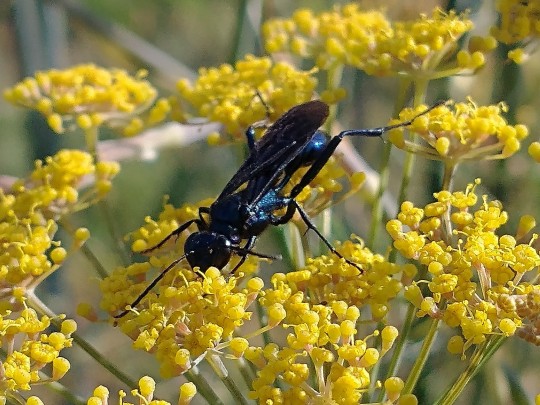

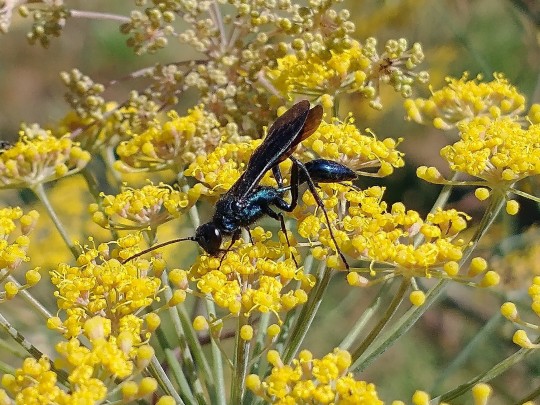
Gorgeously iridescent, but shy. Likely a common blue mud-dauber (Chalybion californicum).
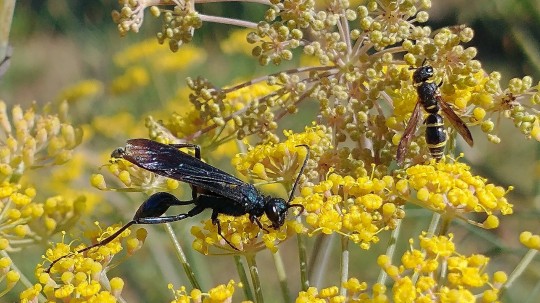

Here it is next to an smaller, unknown potter wasp.
3 notes
·
View notes
Photo

I’m not sure what this little one is I think she’s a mud dauber maybe?
I tried for a good half hour to get a picture that looked any good and this is as good as I could do. They are very very very skittish and I could not get a shot that showed off just how vividly blue they are.
I’ll try again on Monday
On the bright side I did learn a new bug hunting technique. If you kinda just sway in the breeze like mantises do they are a lot calmer about you being there. I feel like I leveled up as a bug hunter. Although now I look like much more of a weirdo.
7 notes
·
View notes
Text
@whocaresgobuckwild submitted: Found this guy in my home a few months back :) location: [removed] (please remove location)

Also sorry if this is very common or something I'm not great with insects jsbsbsh
No problem, most people can't ID random wasps! Looks like a thread-waisted wasp in Sphecidae, more specifically a blue mud-dauber wasp. I won't mention which species exactly, as that may give away your general location.
50 notes
·
View notes
Text
I haven't managed to get a lot of pics recently but I HAVE seen quite a few wasps around! Including: an iridescent blue/green cuckoo wasp, a small wasp (potter wasp?) with oddly round abdomen (as opposed to pointed at the end), a black ichneumon wasp drilling into a fence, a wasp that appeared to be mostly bright red and that acted like a mud dauber as it dug into some sand, another mason wasp that got into my room through the window (successfully freed), a thread-waisted wasp that seems to like drinking/collecting rain water from one particular spot, and a pair of yellow jackets (common yellow jacket and bald faced hornet respectively) fighting each other midair!
3 notes
·
View notes
Text
lmao i was talkin about bugs with my mamma and i managed to name over 100 bugs/arthropods that i’ve seen with my own eyes. i’m so proud of my bug-seeing. <3
big dipper firefly
brown chafer
japanese beetle
cucumber beetle
seven spotted ladybug
rove beetle
eastern hercules beetle
six spotted neolema beetle
brown marmorated stink bug
eastern leaf-footed bug
leaf hopper
dog day cicada
periodical cicada
waterboatmen
backswimmers
wheel bug
thread-legged assassin bug
pselliopus assassin bug
polyphemus moth
pandora sphinx moth
luna moth
tiger moth
snowy urola moth
hummingbird moth
nessus sphinx moth
somber carpet moth
wavy lined emerald moth (caterpillar)
eastern tent moth
eastern tent moth caterpillar
snowberry clearwing moth
monarch butterfly
tiger swallowtail butterfly
black swallowtail butterfly
zebra swallowtail butterfly
zebra wing butterfly
fiery skipper butterfly
silver spotted skipper butterfly
peck’s skipper butterfly
red admiral butterfly
red spotted purple admiral butterfly
cabbage white butterfly
common buckeye butterfly
chinese mantis
carolina mantis
field cricket
camel cricket
bush cricket/katydid
giant lubber grasshopper
american cockroach
german cockroach
oriental cockroach
carpenter ants
dobsonfly
widow skimmer dragonfly
red saddlebags dragonfly
black saddlebags dragonfly
autumn meadowhawk dragonfly
blue dasher dragonfly
ebony jewelwing damselfly
whitetail skimmer dragonfly
green darner dragonfly
earwig :(
pill millipede
wood louse
house centipede
mosquitos, duh
fruit flies, duh
robber flies
crane flies
picture-winged flies
cicada killer wasp
european hornet
bald faced hornet
eastern paper wasp
european paper wasp
eastern yellowjacket
european yellowjacket
southern yellowjacket
red paper wasp
common paper wasp
black and yellow mud dauber wasp
common thread waisted wasp
cuckoo wasp
spider wasp
mason bee
european honey bee
sweat bee
eastern bumblebee
american bumblebee
carpenter bee
four toothed mason wasp
carolina wolf spider gotDAMN those motherfuckers are ENORMOUS
crab spider
marbled orb weaver
black widow spider
cobweb spiders
cellar spiders
three spotted jumping spider
american giant millipede
northern walkingstick
planthopper
tiger bee fly
box elder bug
large milkweed bug
SO MANY BUGS TO SEE
#the :( by the earwig is bc an earwig got in my mouth when i was in kindergarten :(#so i Don't Like Them
6 notes
·
View notes
Note
Got any cool pictures of bugs to share???
DO I!

Found this velvet ant (actually a kind of ground-dwelling wasp) on the ground outside my house a few months ago!

And this bee was on our sunflowers yesterday— I think iNaturalist identified it as a litigated furrow bee

This is a short-horned grasshopper!

A mud-dauber, one of the thread-waisted wasps

A rock bristletail! These are interesting because they belong to one of the basalmost insect orders, the Archaeognatha. (Fun fact: my mom found a jumping bristletail the other day and was like JESUS WHAT IS THAT because it did in fact jump at her.)

A blue dasher, and I’m still proud of how this picture turned out.

A common snakefly! (Which is a misnomer, seeing as they’re not actually flies.) Check out the neck and the ovipositor (no, that is not a stinger)

Ladybug nymph! Not exactly uncommon, but still cool to look at.

Spotted cucumber beetle found on one of our squash plants, which mom wasn’t happy about

And an honorable mention to this picture of a honeybee I got because I’m also really proud of how it turned out.
I can only add 10 pictures to a post at a time so that’s all for now but I’ll continue bringing you insect updates!
21 notes
·
View notes
Photo










Common Blue Mud Dauber Wasp - Chalybion californicum
Mud Dauber Wasps tend to be rather skittish and shy, especially when it comes to photography. Even if some individuals are found, it’s not a guarantee that they’ll want to stick around to be photographed, even if you’re far from them. They’ll take notice of you and then fly away to escape! It’s such behavior like that which gives a picture like Pictures 2 and 7. From my experience, the best way to photograph a Mud-Dauber is to find one that’s either preoccupied by something or during cold days when their movement is sluggish. For example, the individuals showcased in the remaining pictures are occupied with different food sources: one individual has found sticky-sweet material on milkweed leaves (which is likely to be honeydew) while the individual on the Japanese maple tree has a bit of something in its mandibles. The latter is a bit strange as adult Mud-Daubers rely on nectar from flowers rather than insects (their Wasp-waist restricts intake of solid food), meaning this is a capture for the nest. Closer inspection reveals it to be a small spider (probably)! Indeed, that’s definitely going to the nest as a provision for their eggs.
As their name suggests, this specie makes a nest in the ground. Sometimes it doesn’t even make a fresh nest, but instead reuses old or abandoned nests to make its home. While anecdotal, my front yard sees the Blue Mud Dauber population return year after year underneath two bushes. It’s possible the nests there are reused generation after generation. Hopefully the close proximity of nests to Wasps doesn’t result in squabbling or territorial disputes. The Wasp not only nests in the ground, but also hunts close to the ground too. This might be a strategy to evade other predators and to hunt spiders who stray away from their webs or those who have yet to build a nest. It’s much more dangerous to fight a spider on its own turf, even with size being in the Wasp’s favor, along with a lot of favorable stinging angles. They do always have the option to ascend to higher altitudes to try their luck at hunting, but more than likely they’ll just find flowers to drink from, and fellow pollinators such as the guest appearance Western Honeybee. Though not as populous as the latter, the efforts of the Blue Mud Dauber have contribution to the pollination and spread of several flowers.
Pictures were taken on June 30, July 7, 8 and August 4, 2019 with a Samsung Galaxy S4.
#jonny’s insect catalogue#ontario insect#wasp#common blue mud dauber wasp#blue mud dauber wasp#digger wasp#hymenoptera#insect#june2019#july2019#august2019#2019#toronto#western honeybee#entomology#nature#invertebrates#arthropods
1 note
·
View note
Note
Excuse me my good fellow do you have any wasps that are... P u r p l e ?
oh ho purple a rare trait for animals indeed and because of that examples of just purple wasp hard to find BUT iridescently purple a bit more common


up top you got the blue mud dauber and under that we have pipe organ dauber they look mostly blue to blueish purple depending on lighting

you also have iridescent cuckoo wasps like this ruby tail with its red to purplish “tail”
and then there’s Chrysis equestris who may not be the most purple of them all but just look at them

rainbow !!!!!
58 notes
·
View notes
Photo

New Post has been published on https://techcrunchapp.com/like-it-or-not-joro-spiders-are-here-to-stay-national-news/
Like it or not, Joro spiders are here to stay | National News

ATLANTA — Chances are, if you live in northeast Georgia you’ve come across an East Asian Joro spider this fall.
At almost 3 inches across when their legs are fully extended, they’re hard to miss. While they’re roughly the same size as banana spiders and yellow garden spiders, the distinctive yellow and blue-black stripes on their backs and bright red markings on their undersides are unique. Their enormous three-dimensional webs are a striking golden color and tend to be located higher off the ground than those of other spiders.
“We’ve been getting lots of calls and emails from people reporting sightings,” Byron Freeman, director of the Georgia Museum of Natural History, said. “They seem to be really common in riparian areas and in urban areas around people’s houses, but they’re also in the deep woods.”
Joro spiders have spread widely in Georgia since they were first spotted in Hoschton in 2013. They probably arrived by hitching a ride in a shipping container from China or Japan, according to Freeman. He and Richard Hoebeke, associate curator of the museum’s arthropod collection and a research professional in the University of Georgia College of Agricultural and Environmental Sciences Department of Entomology, confirmed the identity of those early arrivals based on genetic analysis in 2015.
Now, five years later, Joro spiders appear to have successfully established themselves in the area, with recent confirmed reports from as far afield as Blairsville and Greenville, S.C. But there is still much that remains unknown about them.
One important question is how they might affect the local ecosystem. Will they outcompete other orb weaving spiders? Will they reduce insect populations through predation?
“We don’t know what the impact is going to be,” Freeman, a faculty member in the University of Georgia Odum School of Ecology, said. “Right now, we’re trying to learn as much as we can about them.”
So far, early observations indicate that Joros are coexisting with the area’s other orb weaving spiders, with webs close to, and in some cases even attached to, one another.
And Joro spiders also appear to be able to capture and feed on at least one insect that other local spiders are not: adult brown marmorated stink bugs, an invasive pest that can infest houses and damage crops. In turn, Joro spiders are vulnerable to predators like mud dauber wasps and birds.
Freeman noted that dewdrop spiders, a kleptoparasite — as the name implies, they steal food from others — have been spotted in Joro webs.
“They may be switching from what we thought was their principal host, the banana spider, to this new kind of orb weaver,” he said. He pointed out that banana spiders, a relative of the Joro, are native to the Caribbean and Central America. They were first recorded in the U.S. in 1862 and have since naturalized.
“My guess is that this will be no different than the banana spider, and I don’t know that we can assess what the effect of the banana spider has been at this point,” he said.
Another question Freeman says he hopes to answer is how the males find their mates.
Joro spiders travel by ballooning, letting the wind carry them on a strand of gossamer.
“The male has to drift in and find the female,” Freeman said. “Sometimes there’ll be four or five males on a web, sometimes there’ll be one, so the males are moving between webs. When you have a large population it seems feasible that a male could just drift from one spot to the next, but when you don’t have a lot of webs around, how does the male show up?”
Freeman is also conducting further genetic analysis to determine what causes some Joro spiders to have a different color pattern. While most have distinctive black and yellow striped legs, some have legs that are solid black. These black morphs have other physical differences that are only apparent when viewed under a microscope, and Freeman has determined that they are genetically distinct members of the species.
Despite their size, Freeman said that Joro spiders don’t pose a threat to people.
“All spiders have venom that they use to subdue prey,” he said. “If you put your hand in front of one and try to make it bite you, it probably will. But they run if you disturb their web. They’re trying to get out of the way.”
Freeman said that Joros can be shooed away with a broom if they’re in a location that puts them too close for comfort.
But as for removing them permanently, he compared such efforts to shoveling sand at the beach.
“Should you try to get rid of them?” said Freeman. “You can, but at this point, they’re here to stay.”
If you spot a Joro spider — especially if you can provide a photo tagged with date and location — contact Hoebeke at [email protected].
Beth Gavrilles is the public relations coordinator for the University of Georgia Odum School of Ecology.
(function(d, s, id) var js, fjs = d.getElementsByTagName(s)[0]; if (d.getElementById(id)) return; js = d.createElement(s); js.id = id; js.src = "https://connect.facebook.net/en_US/sdk.js#xfbml=1&version=v2.5&appId=1076755405678815"; fjs.parentNode.insertBefore(js, fjs); (document, 'script', 'facebook-jssdk'));
0 notes
Photo


(via A GUIDE TO STINGING INSECTS IN THE 4 STATES)
A GUIDE TO STINGING INSECTS IN THE 4 STATES paper wasp on a flower in st louis mo There are many stinging insects that call Missouri, Oklahoma, Kansas, and Arkansas home, and for the most part, these are beneficial insects. Bees are vital for pollination and, while wasps can do some pollination, they are considered more beneficial in the way they help to control plant-damaging pests like caterpillars. But, while stinging insects can be a benefit to us, they have the unfortunate ability to cause us harm as well. Here are a few of the stinging insects you may find on your 4 States property, and what you need to know most about them. Paper Wasp swarming insect The most common stinging insect you’ll find on your 4 States property is the paper wasp. These social wasps have a widespread distribution throughout the entire state. They vary in appearance, depending on the species, and can be yellow and black to brown, black, and yellow. Some species look like skinny yellow jackets. Paper wasps make aerial nests on overhangs, arches, and eaves. This brings them into close proximity of humans. Paper wasps are overwintering pests. For this reason, they will invade homes that have holes in screens, or entry points in siding, eaves, window frames, or soffits. Paper wasps are social insects that defend their nests but are generally not aggressive on their own. When a paper wasp comes near, avoiding erratic movements can help prevent a sting. Yellow Jacket (social) aggressive scavenger insect Of all the stinging insects you can have on your property, yellow jackets are the worst. These are social insects that can swarm and give chase. They have also been observed going around objects to get to their target. But, this behavior is only one of many reasons these insects are a problem. Yellow jackets are fond of meat. While they are not known to kill large animals, they scavenge carcasses and carry balls of meat back to their nest. This desire for meat can make a cookout particularly inviting to these pests. Yellow jackets have a wide range of foods they will eat. This diverse diet will lure them to dumpsters, trash heaps, and trash cans. Yellow jackets often build their nests in the ground and are aggravated by vibrations. This can cause them to swarm a lawn mower or other machinery. Carpenter Bee wood-damaging pest Often mistaken for bumble bees, the carpenter bee has a similar furry yellow and black appearance. But, unlike the bumble bee, a carpenter bee will have an abdomen that is entirely black, and entirely hairless. This visual characteristic helps to easily identify these bees from a distance. Carpenter bees are solitary insects. You don’t have to worry about these bees swarming when you get near to where they are nesting. Male carpenter bees are not able to sting, but they are known to fly menacingly at any creature they believe is a threat to their nest. While carpenter bees are not a stinging threat, they are able to damage wood. Female carpenter bees bore circular tunnels in wood to make a home for their offspring. If these tunnels are left untreated, they can be used, and expanded on each year. While carpenter bees are not a stinging threat, they are able to damage wood. Female carpenter bees bore circular tunnels in wood to make a home for their offspring. If these tunnels are left untreated, they can be used, and expanded on each year. The damage carpenter bees do to outside steps and railings can pose a danger if these give way. Sweat Bee attracted to perspiration As their name implies, sweat bees are drawn to land on skin that is covered in a film of perspiration. There are around 70 species of sweat bee in the state of 4 States. Some species are solitary and some are social. The most notable visual characteristic of sweat bees is the metallic shade of green, blue, or bronze they have. If you have a nest of social sweat bees on your property, they could easily become a problem, especially on a hot day. These bees are not usually aggressive. But they may sting if they feel their nest is being threatened. Sweat bees usually only sing when they are accidentally pressed against the skin. Mud Dauber accidental stinging pest The mud dauber has many names: mud wasps, dirt daubers, organ pipe wasps, potter wasps, and more. There are several species of mud dauber in Missouri, but they all share one trait in common; they build their nests out of mud. The identifying characteristic of a mud dauber is its extremely thin waist. These are nonaggressive wasps that only sting when pressed against the skin. If you have any issues with stinging pests on your 4 States property, reach out to us. The Bug Lady Pest Control, serving Grove, Jay, Miami, Joplin, Neosho, Anderson, Goodman, Prairie Grove, Bella Vista, Centerton, Bentonville, Rogers, Gravette, Springdale, Fayetteville.
0 notes